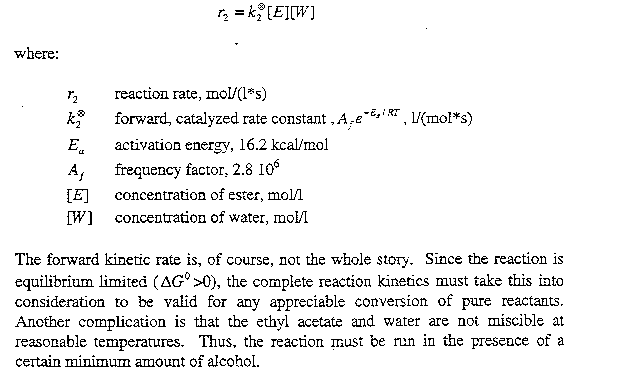Hydrolysis of Ethyl Acetate
(recommended by Bjorn Tyreus, DuPont)
Your company has a process that generates a co-product stream containing 50 wt% ethyl acetate in ethanol. The average rate of the stream is 1,000 pph. Since the main process uses both ethanol and acetic acid it appears wasteful to get rid of the co-product stream. July, 1999 market values of 190-proof ethanol range from $1.35 to $2.10/gal, whereas fuel-grade ethanol can be purchased for $1.05 to $1.40/gal. The price for acetic acid is $0.38/lb and ethyl acetate could be sold for $0.6/lb. At first glance, it would appear lucrative to separate the ethanol from the ethyl acetate, use the ethanol in the main process and sell the ethyl acetate as a co-product. This could generate substantial revenue to the company to help offset the loss of ethanol and acetic acid contained in the ethyl acetate. Unfortunately, this simple idea won’t work since the co-product stream contains low levels of impurities that are difficult to remove. These impurities come from the main process where they are consumed in a reaction step. Thus, it would be acceptable to produce acetic acid and ethanol from the co-product stream and recycle these materials back to the main process. This is the plan you should pursue.
In thinking about how to make acetic acid and ethanol from ethyl acetate, you quickly realize that ethyl acetate is the ester of the first two species. Also, you may recall that esters are formed from organic acids and alcohol by liberating water. In the main process, the following reaction may be the source of ethyl acetate.
CH3COOH + CH3CH2OH ® CH3COOCH2CH3 + H2O (1)
The question is whether we can design a plant that reverses the reaction by adding water to the ethyl acetate. In other words, is the hydrolysis reaction feasible?
CH3COOCH2CH3 + H2O ® CH3COOH + CH3CH2OH (2)
From your thermodynamics and reaction engineering training, you will recall that the issue of whether or not a reaction is feasible depends on the sign and magnitude of the Gibbs free energy of reaction:
![]() = the Gibbs free energy change
of reaction (2) when all the components are in their standard states.
= the Gibbs free energy change
of reaction (2) when all the components are in their standard states.
![]() = activity of alcohol in
the reaction mixture.
= activity of alcohol in
the reaction mixture.
![]() = activity of ester in the
reaction mixture.
= activity of ester in the
reaction mixture.
![]() = activity of water in the
reaction mixture.
= activity of water in the
reaction mixture.
When the standard states are chosen as the pure-liquid species at 298
K and 1 atm, it has been determined that ![]() =
1.52 kcal/mol. From this, we see that the reaction won’t occur to any useful
extent under standard-state conditions and that the reactor must be operated
at other conditions. You must decide what constitutes suitable reaction
conditions.
=
1.52 kcal/mol. From this, we see that the reaction won’t occur to any useful
extent under standard-state conditions and that the reactor must be operated
at other conditions. You must decide what constitutes suitable reaction
conditions.
Once a set of conditions has been selected to make Reaction (2) feasible, you must determine how fast the reaction will proceed; that is, the kinetics of the reaction. For the purpose of this study, you may assume that a small, but sufficient, amount of a homogeneous acid catalyst is added to the reaction mixture to cause the following kinetic rate expression to be valid for the forward rate of Reaction (2). You may assume that the catalyst is neutralized upon exit from the reactor such that no further reaction takes place in the downstream equipment. The rate expression is:

Once you have determined the best operating strategy for the reactor,
you need to address the separation of the reactor effluents. These species
are very non-ideal and may form several azeotropes, making separation by
distillation a challenge. You need to design a separation train that allows
you to bring ethanol and acetic acid back to the main process while providing
a recycle of ethyl acetate and water to the hydrolysis reactor. The main
requirements are that the ethanol and acetic acid streams should contain
essentially no ethyl acetate and less than 5 wt% water in the combined
streams of ethanol and acetic acid. The ethanol and acetic acid streams
should be separate to prevent esterification in the transfer to the main
process.
In summary, the task of this project is to design a reactor and a separation train to recover ethanol and acetic acid from ethyl acetate. The process should be optimized for the lowest overall cost (investment and operating) while making sure that the process is operable. To this end, you need to design a plantwide control strategy for the process and test this using dynamic simulations. In particular the plant should be able to handle a 50% turndown in the overall feed rate that might occur in less than 15 minutes. In addition, the concentration of ethyl acetate may vary between 40 and 60% during the course of an hour.
Assume the following utility costs :
| 150 psig steam | $5 /1,000 lb |
| 50 psig steam | $4 /1,000 lb |
| Cooling tower water | $0.09/1,000 gal |
| Raw water (makeup) | $0.55/1,000 gal |
| -25° C Refrigeration | $0.12/(hr ton) |
| Electricity | $0.065/kWh |